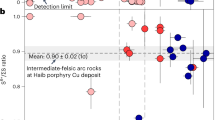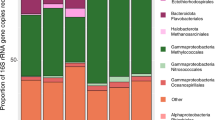Abstract
In recent marine sediments, bacterial reduction of seawater sulphate is responsible for the formation of diagenetic sulphides, which are typically strongly depleted in 34S relative to source sulphate, and highly variable in their δ 34S values. In contrast, the δ 34S values of Archaean sedimentary sulphides are generally found to be less variable and nearly identical to those of sulphates in the same sedimentary units. This finding has led previous investigators1–4 to suggest that either sulphate-reducing bacteria had yet to develop in Archaean time, (especially before ∼2.75 billion years ago), and/or Archaean oceans contained much less sulphate (<< lmM compared with the present value of 28 mM), implying that the Archaean atmosphere contained much less free oxygen than the present atmosphere. But the sulphur isotope data on Archaean sediments from ∼2.6 to 3.5 x 103 Myr old can be better explained if sulphate-reducing bacteria were already active in oceans with temperatures of ∼30 to ∼50°C, and containing appreciable amounts (>1 mM) of sulphate, with δ 34S values of +3%
This is a preview of subscription content, access via your institution
Access options
Subscribe to this journal
Receive 51 print issues and online access
$199.00 per year
only $3.90 per issue
Buy this article
- Purchase on SpringerLink
- Instant access to full article PDF
Prices may be subject to local taxes which are calculated during checkout
Similar content being viewed by others
References
1. Perry, E. C., Monster, J. & Reimer, T. O. Science 171, 1015–1016 (1971). 2. Goodwin, A. M., Monster, J. & Thode, H. G. Econ. Geol. 71, 870–891 (1976). 3. Donnelly, T. H. et al. J. geol. Soc. Ami. 24, 409–420 (1977). 4. Monster, J. et al. Geochim. cosmochim. Acta 43, 405–413 (1979). 5. Claypool, G. E., Holser, W. T., Kaplan, I. R., Sakai, H. & Zak, I. Chem. Geol. 28, 199–260 (1980). 6. Ohmoto, H., Kaiser, C. J. & Geer, K. A. Spec. Publ. geol. Soc. Aust. (in the press). 7. Thode, H. G. & Monster, J. in Fluids in Subsurface Environments (eds Young, A. & Galley, J. E.) 367–377 (Am. Ass. Petrol. Geol. Memoir 4, 1965). 8. Lambert, I. B., Donnelly, T. H., Dunlop, J. S. R. & Groves, D. I. Nature 276,808–811 (1978). 9. Broda, E. The Evolution of Bioenergetic Processes (Pergamon, Oxford, 1975). 10. Schidlowski, M., Haves, J. M. & Kaplan, I. R. in Earth's Earliest Biosphere, Its Origin and Evolution (ed. Schopf, J. W.) 149–186 (Princeton University Press, 1983). 11. Kaplan, I. R. & Rittenberg, S. C. J. gen. Microbiol. 34, 195–212 (1964). 12. Ohmoto, H. & Rye, R. O. in Geochemistry of Hydrothermal Ore Deposits 2nd edn (ed. Barnes, H. L.) 509–576 (Wiley, New York, 1979). 13. Holland, H. D. The Chemical Evolution of the Atmosphere and Oceans (Princeton University Press, 1984). 14. Heinrichs, T. K. & Reimer, T. O. Econ. Geol. 72, 1426–1441 (1977). 15. Vinogradov, V. I., Reimer, T. O., Leites, A. M. & Smelov, S. B. Lithol. Miner. Resources 11,407–420 (1977). 16. Berner, R. A. Geochim. cosmochim. Acta 48, 605–617 (1984). 17. Goldhaber, M. B. & Kaplan, I. R. Soil Sci. 119, 42–55 (1975). 18. Goldhaber, M. B. & Kaplan, I. R. in The Sea Vol. 5, Marine Chemistry (ed. Goldberg, E. D.) 569–655 (Wiley, New York, 1974). 19. Fripp, R. E. P., Donnelly, T. H. & Lambert, I. B. Spec. Publs geol. Soc. S. Afr. 5, 205–208 (1979). 20. Harrison, A. G. & Thode, H. G. Trans. Faraday Soc. 54, 84–92 (1958). 21. Kemp, A. L. W. & Thode, H. G. Geochim. cosmochim. Acta 32, 71–91 (1968). 22. Chambers, L. A., Trudinger, P. A., Smith, J. W. & Burns, M. S. Can. J. Microbiol. 21, 1602–1607 (1975). 23. Thode, H. G. & Goodwin, A. M. Precambr. Res. 20, 337–356 (1983). 24. Hoefs, J., Nielsen, H. & Schidlowski, M. Econ. Geol. 63, 975–977 (1968). 25.Ripley, E. M. & Nicol, D. L. Geochim. cosmochim. Acta 45, 839–846 (1981). 26. Postgate, J. R. The Sulphate–reducing Bacteria 2nd edn (Cambridge University Press, 1984). 27. Segerer, A,, Stetter, K. O. & Klink, F. Nature 313, 787–789 (1985).
Author information
Authors and Affiliations
Rights and permissions
About this article
Cite this article
Ohmoto, H., Felder, R. Bacterial activity in the warmer, sulphate-bearing, Archaean oceans. Nature 328, 244–246 (1987). https://doi.org/10.1038/328244a0
Received:
Accepted:
Issue date:
DOI: https://doi.org/10.1038/328244a0
This article is cited by
-
The Transfiguration continental red-bed Cu–Pb–Zn–Ag deposit, Quebec Appalachians, Canada
Mineralium Deposita (2009)
-
Faint Young Sun, Planetary Paleoclimates and Varying Fundamental Constants
International Journal of Theoretical Physics (2005)
-
Sulphur isotope fractionation in modern microbial mats and the evolution of the sulphur cycle
Nature (1996)
-
Atmospheric carbon dioxide concentrations before 2.2 billion years ago
Nature (1995)
-
A hydrothermally precipitated catalytic iron sulphide membrane as a first step toward life
Journal of Molecular Evolution (1994)



